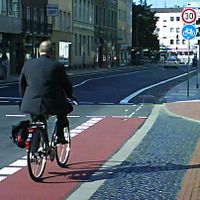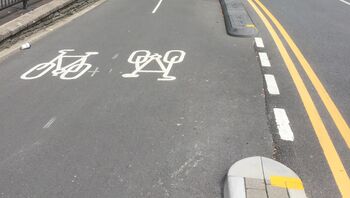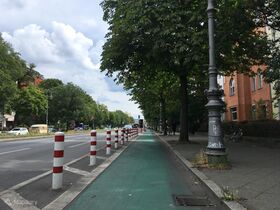Key:cycleway
 |
| Description |
|---|
| Determines whether there are or what kind of cycle lanes or tracks provided within the carriageway or next to it. |
| Group: cycleways |
| Used on these elements |
| Documented values: 18 |
| Requires |
|
| Implies |
| Useful combination |
| See also |
| Status: de facto |
| Tools for this tag |
|
The cycleway=* tagging is used on ![]() linear features tagged with
linear features tagged with highway=* to map cycling infrastructure that is an inherent part of the road. This specifically applies to:
- cycle lanes which are part of the road without any physical separation from the other lanes except the painting on the road (don't map them as separate ways),
- cycle tracks that are running parallel and next to the road (consider map them as separate ways with
highway=cycleway, orhighway=path+bicycle=designatedin case of shared foot- and bicycle ways).
If no cycling infrastructure is present, you should indicate this by using the value no (see below).
cycleway=asl for advanced stop lines is the only case in which the key cycleway=* is used on ![]() nodes instead of
nodes instead of ![]() way features.
way features.
For bicycle roads/cycle streets where the full carriageway may be used primarily by bicycles, see bicycle_road=yes and cyclestreet=yes.
In addition, cycleway=* is also used to specify the type of highway=cycleway similar to how footway=* is used to describe highway=footway in detail. This makes it a homonymous key and data consumers should consider the different uses thereof.
See also the Bicycle page for a number of illustrated examples on how to map specific cycling infrastructure situations.
Using side attributes
- Main article: Forward & backward, left & right
It is advisable to use cycleway tags in combination with side attributes, i.e. cycleway:left=*, cycleway:right=* or cycleway:both=* (instead of a simple cycleway=*). This clearly indicates which side of the road an infrastructure specification refers to. The terms "right" and "left" are relative to the direction in which the way was drawn in the editor, and not necessarily the direction of real-world travel. (In the iD editor, for example, the direction is indicated by arrows at the mid-point of each segment of the way.)
It is assumed that cycle traffic is allowed to flow in the customary direction for traffic on that side of the road (which, for oneway=yes roads, is the same on both sides and in agreement with the motorised traffic) – unless otherwise specified by oneway=* tags (e.g. cycleway:right:oneway=no or cycleway:left:oneway=-1, see also the chapter on #Bicycle infrastructure in one-way roads below).
Common values
Cycleway
To describe infrastructure designed mainly for cyclists. See also: Cycle routes.
| Value | Element | Comment | Photo | |||
|---|---|---|---|---|---|---|
Dedicated bicycle lanes | ||||||
lane
|
A bicycle lane is an inherent part of the road itself. It has no physical separation from the other lanes except the painting on the road. In North America, known as a class II bicycle facility. Notably, there is no curb between the cycle lane and the road.
Some countries have two different types of cycle lanes:
To distinguish between these two types of cycle lanes, the cycle lane can additionally be tagged with
|
 | ||||
|
| ||||||
shared_lane
|
Cyclists share a lane with motor vehicles, and there are markings (like The road markings are usually there to highlight a cycle route or to remind drivers that you can cycle there. |
 | ||||
share_busway
|
A special lane reserved for public transport on which cyclists are also allowed to bike. |  | ||||
Bicycle tracks | ||||||
track
|
A cycle track is separated from the road by curbs, parking lots, grass verges, trees, bollards or another physical barrier, but is running parallel and next to the road. In North America this is called a protected bike lane, separated bike lane, greenway, green lane, or class IV facility.[1]
Alternatively, consider mapping cycle tracks as a separate way next to the road tagged as In the USA, general practice is to use this tag when the bike lane is protected by parking with or without bollards/flex posts. E.g. the parking lane is between the vehicle travel lane and the bike lane. Where the bike lane is bi-directional and protected by bollards, general practice has been to draw this bike lane as a separate way even if it is not vertically separated from the vehicle travel lanes. |
 | ||||
separate
|
Should be used to indicate that a cycle track associated with a highway has been mapped as a separate OSM element (i.e., is tagged with highway=cycleway). Meaning is similar to the use of sidewalk=separate for footways, and can potentially be used when simplifying geometries for rendering. It also acts as a hint to avoid duplicating an existing cycleway by adding cycleway=track to a highway. Don't confuse with segregated=yes.
|
|||||
No bicycle infrastructure | ||||||
no
|
Explicitly marks that a street has no bicycle infrastructure. This allows to explicitly note that the road was surveyed for bicycle infrastructure. |  | ||||
Other bicycle infrastructure | ||||||
crossing
|
Used on separately mapped paths to indicate that it's a bicycle crossing. |  | ||||
shoulder
|
Used to indicate that a road has no designated infrastructure for cyclists, but shoulders (a.k.a. breakdown lanes) are navigable and legal to cycle on. Especially on rural roads with high speed limits, the existence of a shoulder usable by cyclists can make the difference whether the road is usable at all (semi-)safely for cyclists. Not every shoulder=* is automatically usable for cyclists: Some shoulders are used for parking (parking=shoulder) instead, not all shoulders are paved (with asphalt, e.g. grass pavers). Additionally, shoulder=yes is typically only mapped for shoulders that are broad enough to accommodate a car. For cyclists however, a less wide shoulder is fine, too.
|
 | ||||
link
|
A connector between OSM segments for cycle traffic, for example to connect a separately mapped cycle path to a junction on the opposite side. Serves primarily as a routing aid and does not necessarily have to be identifiable as built infrastructure. |  | ||||
traffic_island
|
Used on the parts of refugee islands of a cycleway=crossing.
|
 | ||||
asl
|
Indicates an advanced stop line or bike box at junctions. Use cycleway=asl on a direction=forward or direction=backward for an explicitly reference to the closest junction that a ASL relates to and thus the direction of traffic that it applies to.
|
 | ||||
gap_jump
|
A gap jump segment of MTB downhill route. Generally would consist of two or three parts: a take-off ramp; a physically non-existent mid-air segment; and optionally a landing ramp (if not present, a regular bike track serves as a landing zone). The mid-air segment may cross other roads or features, in which case it should be tagged with layer=1 without a node at the intersection; surface=none has occasionally been added as well. Consider explicitly providing foot=no or access=no + bicycle=designated in order to prevent routing for any other activity.
|
 | ||||
Deprecated or discouraged tags | ||||||
opposite |
Formerly used in one-way roads before oneway:bicycle=* was used. See below how to map bicycle infrastructure in one-way roads.
| |||||
shared |
Formerly used on cycleways which were mapped as separate ways tagged as highway=cycleway before the segregated=* tag was formalized. Its use with highway=cycleway is now considered obsolete.
| |||||
This table is a wiki template with a default description in English. Editable here.
Bicycle infrastructure in one-way roads

oneway=yes+
oneway:bicycle=no+
cycleway:right=no+
cycleway:left=lane+
cycleway:left:oneway=-1Add oneway:bicycle=no on one-way roads that are open to bicycle traffic in the opposite direction.
In addition, the cycleway tags are used as usual to specify the bicycle infrastructure on each side of the road, seen in direction of the OSM way element (e.g. cycleway:both=no or cycleway:left=lane). For cycle paths in one-way streets, it is especially recommended to provide cycleway tags with side information so that there is no confusion as to which side (and therefore in which direction of travel) a cycle path is available. Therefore, use cycleway:right=*, cycleway:left=* and cycleway:both=* to ensure that this information is always provided.
If a cycle path is a contraflow bicycle way, i.e. runs in the opposite direction to the one-way street, it is necessary to explicitly specify a direction of travel for this cycle path that differs from the general direction of travel (e.g. cycleway:left:oneway=-1). This is necessary since otherwise it is generally assumed that cycle traffic is allowed to flow in the customary direction for traffic on the specified side of the road, which is the same on both sides for one-way roads. See cycleway:oneway=* for details and examples on how to correctly use oneway tags for cycle lanes and tracks in one-way roads.
Per-lane
In rare cases where cycleway=* isn't sufficient even with a direction suffix (e.g. because the cycle lanes is located between two motor lanes), cycleway:lanes=* is used instead. Others go further and specify the access on a per-lane bases with bicycle:lanes=* and access:lanes=* (with or without cycleway:lanes=*).
Some mappers also use this mapping in cases where cycleway:left/both/right=* is sufficient.
Buffered and protected bicycle ways
A buffered cycle lane is separated from the car lanes with extra space. This is still tagged as cycleway=lane but with cycleway:buffer=* added. For more specific tagging, the cycleway:left:buffer=*, cycleway:right:buffer=*, or cycleway:both:buffer=* variants can also be used.
Cycle paths that are physically separated/protected from moving traffic (e.g. by bollards, flower pots or even a row of parked vehicles) are usually understood as cycle track. To indicate the type of physical separation, there is the proposed cycleway:separation=* tagging.
 cycleway:buffer=*). |
 cycleway:separation=*). |
Supplementary details
If tracks or lanes for bicycles are tagged on a highway, the prefix cycleway: can be used as a namespace for other tags. This has the meaning of limiting the details to just the cycleway. Additionally the namespace can be combined with :left, :right, :both suffixes in the usual way, resulting in cycleway:both=*, cycleway:left=*, cycleway:right=* tags and their variants.
Meaningful cycleway attributes, which could be added, are in particular:
- cycleway width, e.g.
cycleway:right:width=3orcycleway:left:width=1.5, - cycleway surface, e.g.
cycleway:both:surface=paving_stonesorcycleway:right:surface=asphalt(especially for cycle tracks, as it is assumed by default that cycle lanes have the samesurface=*as thehighway=*itself), - cycleway smoothness, e.g.
cycleway:right:smoothness=good, - cycleway traffic sign (
cycleway:both:traffic_sign=*),
For cycle tracks, consider drawing them as separate geometry and capturing these attributes (without the cycleway prefix) on this separate ![]() way (e.g.
way (e.g. highway=cycleway + surface=* + width=*), as the attributes there are used by more software/data consumers.
See also
- Bicycle
- Forward & backward, left & right
highway=cyclewaybicycle_road=yes,cyclestreet=yes- Cycle routes, United Kingdom National Cycle Network, London Cycle Network
- Bicycle data projects:
- Pedestrian lanes
External links
 Cycling infrastructure
Cycling infrastructure Bike lane
Bike lane Bikeway safety – a measure of how protected a bike lane is from other traffic, could be a possible data value to inform planning
Bikeway safety – a measure of how protected a bike lane is from other traffic, could be a possible data value to inform planning
| ||||||||||||||||||||||||||||||

